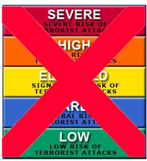 This week the Department of Homeland Security is replacing the much-lampooned color-coded Homeland Security Advisory System with a new system, the National Terrorism Advisory System. When introducing the new system, Janet Napolitano, Secretary of Homeland Security stated, “Today I announce the end of the old system of color-coded alerts. In its place, we will implement a new system that’s built on a clear and simple premise: When a threat develops that could impact you—the public—we will tell you. We will provide whatever information we can so you know how to protect yourselves, your families, and your communities”[i]. Click here for an example of a NTAS bulletin.
This week the Department of Homeland Security is replacing the much-lampooned color-coded Homeland Security Advisory System with a new system, the National Terrorism Advisory System. When introducing the new system, Janet Napolitano, Secretary of Homeland Security stated, “Today I announce the end of the old system of color-coded alerts. In its place, we will implement a new system that’s built on a clear and simple premise: When a threat develops that could impact you—the public—we will tell you. We will provide whatever information we can so you know how to protect yourselves, your families, and your communities”[i]. Click here for an example of a NTAS bulletin.
This change is years overdue, as both politicians and comedians have long recognized. But will the new system be more effective? The bulletins are certainly going to be informative … if the public will read them. But first the government has to get the public to recognize that there is a threat and get them to understand the severity of that threat, so that they will be willing to seek out and read the information provided. This is where I believe the system will fail.
The National Terrorism Advisory System consists of two levels of alert: Elevated Threat and Imminent Threat. But I question whether the general public will understand which of these levels is more severe. I can’t help but be reminded of the tornado alert system which also uses two levels: Tornado Warnings and Tornado Watches. Having grown up in Tornado Alley, I know—without any hesitation—which is which, but I’ve discovered that many of my friends and colleagues in PA don’t. Their logic is usually along these lines:
A Tornado Watch could mean that they are actively watching a tornado that is already on the ground or it could mean that they are watching for a tornado to form. A Tornado Warning could be a warning that a tornado may form in your area or it could be a warning that one already has.
Less than a month ago, a tornado touched down not far from our area, yet I still had people give me the wrong answer when I asked which one meant that you should seek cover immediately (answer: a Tornado Warning means that a tornado is on the ground in your area and you should immediately seek cover).
So I question whether the general public will understand that an imminent threat is more severe than an elevated threat. You may now be saying: “Wait a second. I can understand the confusion between watch and warning since the interpretation can be vague, but surely imminent and elevated are much less ambiguous”. Perhaps to you and me, but these words are at a reading level above the average 9th grade reading level of most America adults[ii]. According to the Plain English Lexicon, it requires a 16th grade level to be able to give a correct definition of imminent[iii] … that’s a college degree. Neither imminent nor elevated are included in Odgen’s Basic English[iv], nor is either included in the Wikitionary 1000 English Basic Words lists[v].
I don’t know about you, but I want to be confident that everyone will know how severe the threat level is at imminent and elevated. This includes the custodian at my child’s school, the high school students working at my local fast food joint, my bus driver, turnpike toll collectors, as well as anyone who may speak English as a second language. Everyone should—without hesitation— be able to understand what each threat level means. I cannot understand why our government chose to use words that are outside of the basic American lexicon as labels for these threat levels.
Only time will tell whether this new system will be effective. I certainly hope that it will be. But the labels of imminent threat and elevated threat simply don’t provide me with that confidence.
[i] “Secretary Napolitano Announces New National Terrorism Advisory System to More Effectively Communicate Information about Terrorist Threats to the American Public”. U.S. Department of Homeland Security. January 27, 2011. http://www.dhs.gov/ynews/releases/pr_1296158119383.shtm.
[ii] Kirsch IS, Jungeblut A, Jenkins L, Kolstad A. Adult Literacy in America. National Center for Education Statistics, U.S. Department of Education, September, 1993, Washington, D.C.
[iii] Cutts, Martin. “Plain English Lexicon: A guide to whether your words will be understood”, Plain Language Commission. 2008.
[iv] http://ogden.basic-english.org/.
[v] http://en.wiktionary.org/wiki/Wiktionary:Frequency_lists.
